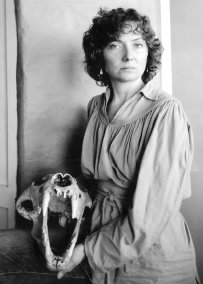 |
| Maria Rutzmoser, curatorial associate of the mammal department at the MCZ, in a portrait from the early 1980s. The bones she guards have new relevance. |
| Photograph by Rosamond Wolff Purcell |
Agassiz flourished during the time of Charles Darwin, but they did not believe one another. Agassiz was a creationist, a resolute foe of the theory of evolution. He argued that the classifications of animals that he formulated were "translations into human language of the thoughts of the Creator." He was studying the mind of God. Ironically, in the twentieth century, his museum would fill with practitioners and promulgators of evolutionary research. The influential evolutionary biologist Ernst Mayr, now Agassiz professor of zoology emeritus, was its director from 1961 to 1970. Big strides in ecology and sociobiology were made there, both fields rooted in evolutionary theory.
When Louis died, friends launched a fundraising drive in his memory. The case statement asserted, "Every workman must have his tools: the tools of a zoologist are collections of natural objects systematically arranged." But the status of systematics sank in the next decades. Biologists' interest in whole-organism research waned, their enthusiasm for cell and molecular biology waxed, and the action moved into the laboratory.
By 1948 Professor Alfred S. Romer, then director of the MCZ, was sounding defensive in his annual report on the state of the museum. He acknowledged that the "wave of research and new discoveries" had "surged beyond the limits of biology and into the area of biochemistry, leaving zoology in a rather chaotic and disorganized condition." That did not mean, however, that zoology should be abandoned. "It is the duty of the museum, as far as it is in its power, to cooperate with its friends and colleagues of the Biological Laboratories in a continued broad development of the field of zoology." Romer got in a final jab asserting the value of old-fashioned zoology: "Recent major advances in evolutionary theory originated in the laboratory development of genetics but owe much to the contributions of systematists and students of geographical distribution. Again it is a fact, although seemingly paradoxical, that museum workers, supposedly dealers in dead bones and stuffed skins, are, in their field work, almost the only zoologists today who have any familiarity with the lives and functions of animals in a state of nature."
Natural-history museums, not just Harvard's, got dusty. The collections began to deteriorate, and funding for refurbishment became a top priority toward the end of the twentieth century at such premier establishments as the Natural History Museum in London and the Muséum National d'Histoire Naturelle in Paris. The fortunes of university museums of natural history in the United States varied, but the decisions made at Princeton, for instance, were not expansive. "The natural-history museum had an ever-smaller constituency," notes a Princetonian, "and more than 12 years ago most of the paleo exhibits were donated to Yale. It is very expensive to maintain and curate a collection of this kind."
In a 1998 article, "Museum research comes off list of endangered species," the journal Nature reported that some of the world's 6,500 natural-history museums are shaking off their image as "dens of antiquity" and showing their relevance to contemporary concerns. The American Museum of Natural History in New York City had just opened a Hall of Biodiversity, leading the way. Biodiversity and how to preserve it, and the environment and how to manage it, are today's urgent topics. Enter museums. "Creating a complete inventory of life on Earth is impossible without reference to museum specimens, while the associated taxonomy and systematics is needed to make rational decisions about conservation," Nature declared. "Museum collections are to biodiversity research what genome databases and cell libraries are to genomics...." And systematists better get cracking: "Although 1.75 million species have been described, the total number is thought to be somewhere between 6 million and 100 million.... With just 15-20,000 new species being described annually, a rapid acceleration is needed."
Worry about losing Romer's "animals in a state of nature" may rescue from neglect the museums around the world in which their aunts and uncles unnaturally reside. Harvard's museums and the scientists affiliated with them surely are well positioned to pursue a holistic, cross-disciplinary approach to preserving biodiversity and protecting the earth's biosphere. Joshua Basseches and his museum colleagues here could choose to address these concerns in exhibits. If they wished, they could focus on local conditions and demonstrate their relevance in close-up ways, as many natural-history museums are doing. The prestigious Field Museum in Chicago is especially active along these lines and has been a catalyst for change in regional public affairs. One can imagine a multidisciplinary exhibit that shows how humans have used the Charles River since before the coming of Europeans, how they abused it, how they are healing it, and what the effects of all this have been on them, on the water table, on the great blue herons feeding along the riverbank, on the insects skimming the water's surface, on the shad run at Cambridge, and on the oyster flats of Allston.






